Hydrogen as a Renewable Energy Carrier in a Hybrid Configuration of Distributed Energy Systems: Bibliometric Mapping of Current Knowledge and Strategies
Abstract
1. Introduction
2. Materials and Methods
Data Collection and Preparation
3. Results and Discussion
4. Conclusions
Author Contributions
Funding
Data Availability Statement
Acknowledgments
Conflicts of Interest
References
- International Energy Agency. Net Zero by 2050—A Roadmap for the Global Energy Sector; International Energy Agency: Paris, France, 2021. [Google Scholar]
- Siddik, M.A.; Islam, M.T.; Mostafa Zaman, A.K.M.; Hasan, M.M. Current Status and Correlation of Fossil Fuels Consumption and Greenhouse Gas Emissions. Int. J. Energy Environ. Econ. 2021, 28, 103–119. [Google Scholar]
- Hangun, B.; Eyecioglu, O.; Beken, M. Investigating the Energy Production Trends of Countries and Its Relationship Between Economic Development. In Proceedings of the 11th IEEE International Conference on Renewable Energy Research and Applications, ICRERA 2022, Istanbul, Turkey, 18–21 September 2022; pp. 597–600. [Google Scholar] [CrossRef]
- Fujiwara, N. Increasing Synergies between Climate Change and Sustainable Development in Energy Policy. In Exploring Synergies and Trade-offs between Climate Change and the Sustainable Development Goals; Springer: Singapore, 2021; pp. 177–212. [Google Scholar] [CrossRef]
- United Nations. The Sustainable Development Goals Report; United Nations: New York, NY, USA, 2021. [Google Scholar]
- Intergovernmental Panel on Climate Change (IPCC). AR6 Synthesis Report Climate Change 2023; IPCC: Geneva, Switzerland, 2023. [Google Scholar]
- BP. Statistical Review of World Energy 2022. 2022. Available online: https://www.bp.com/content/dam/bp/business-sites/en/global/corporate/pdfs/energy-economics/statistical-review/bp-stats-review-2022-full-report.pdf (accessed on 11 July 2023).
- International Renewable Energy Agency. World Energy Transitions Outlook 2022: 1.5 °C Pathway—Executive Summary; International Renewable Energy Agency: Masdar City, United Arab Emirates, 2022; ISBN 9789292604295. [Google Scholar]
- Ammari, C.; Belatrache, D.; Touhami, B.; Makhloufi, S. Sizing, Optimization, Control and Energy Management of Hybrid Renewable Energy System—A Review. Energy Built Environ. 2022, 3, 399–411. [Google Scholar] [CrossRef]
- Casalicchio, V.; Manzolini, G.; Prina, M.G.; Moser, D. From Investment Optimization to Fair Benefit Distribution in Renewable Energy Community Modelling. Appl. Energy 2022, 310, 118447. [Google Scholar] [CrossRef]
- Eghbali, N.; Hakimi, S.M.; Hasankhani, A.; Derakhshan, G.; Abdi, B. Stochastic Energy Management for a Renewable Energy Based Microgrid Considering Battery, Hydrogen Storage, and Demand Response. Sustain. Energy Grids Netw. 2022, 30, 100652. [Google Scholar] [CrossRef]
- Vargas-Salgado, C.; Berna-Escriche, C.; Escrivá-Castells, A.; Díaz-Bello, D. Optimization of All-Renewable Generation Mix According to Different Demand Response Scenarios to Cover All the Electricity Demand Forecast by 2040: The Case of the Grand Canary Island. Sustainability 2022, 14, 1738. [Google Scholar] [CrossRef]
- Vera, Y.E.G.; Dufo-López, R.; Bernal-Agustín, J.L. Energy Management in Microgrids with Renewable Energy Sources: A Literature Review. Appl. Sci. 2019, 9, 3854. [Google Scholar] [CrossRef]
- Bukar, A.L.; Tan, C.W.; Said, D.M.; Dobi, A.M.; Ayop, R.; Alsharif, A. Energy Management Strategy and Capacity Planning of an Autonomous Microgrid: Performance Comparison of Metaheuristic Optimization Searching Techniques. Renew. Energy Focus 2022, 40, 48–66. [Google Scholar] [CrossRef]
- Lamnatou, C.; Chemisana, D.; Cristofari, C. Smart Grids and Smart Technologies in Relation to Photovoltaics, Storage Systems, Buildings and the Environment. Renew. Energy 2022, 185, 1376–1391. [Google Scholar] [CrossRef]
- Piotrowska, B.; Słyś, D. Variant Analysis of Financial and Energy Efficiency of the Heat Recovery System and Domestic Hot Water Preparation for a Single-Family Building: The Case of Poland. J. Build. Eng. 2023, 65, 105769. [Google Scholar] [CrossRef]
- Kordana-Obuch, S.; Starzec, M. Horizontal Shower Heat Exchanger as an Effective Domestic Hot Water Heating Alternative. Energies 2022, 15, 4829. [Google Scholar] [CrossRef]
- Putkonen, N.; Lindroos, T.J.; Neniškis, E.; Žalostība, D.; Norvaiša, E.; Galinis, A.; Teremranova, J.; Kiviluoma, J. Modeling the Baltic Countries’ Green Transition and Desynchronization from the Russian Electricity Grid. Int. J. Sustain. Energy Plan. Manag. 2022, 34, 45–62. [Google Scholar] [CrossRef]
- Anoune, K.; Bouya, M.; Astito, A.; Abdellah, A. Ben Sizing Methods and Optimization Techniques for PV-Wind Based Hybrid Renewable Energy System: A Review. Renew. Sustain. Energy Rev. 2018, 93, 652–673. [Google Scholar] [CrossRef]
- Barhoumi, E.M.; Okonkwo, P.C.; Ben Belgacem, I.; Zghaibeh, M.; Tlili, I. Optimal Sizing of Photovoltaic Systems Based Green Hydrogen Refueling Stations Case Study Oman. Int. J. Hydrogen Energy 2022, 47, 31964–31973. [Google Scholar] [CrossRef]
- Jurasz, J.; Canales, F.A.; Kies, A.; Guezgouz, M.; Beluco, A. A Review on the Complementarity of Renewable Energy Sources: Concept, Metrics, Application and Future Research Directions. Sol. Energy 2020, 195, 703–724. [Google Scholar] [CrossRef]
- Rahman, M.M.; Oni, A.O.; Gemechu, E.; Kumar, A. Assessment of Energy Storage Technologies: A Review. Energy Convers. Manag. 2020, 223, 113295. [Google Scholar] [CrossRef]
- Kebede, A.A.; Kalogiannis, T.; Van Mierlo, J.; Berecibar, M. A Comprehensive Review of Stationary Energy Storage Devices for Large Scale Renewable Energy Sources Grid Integration. Renew. Sustain. Energy Rev. 2022, 159, 112213. [Google Scholar] [CrossRef]
- Choudhury, S. Review of Energy Storage System Technologies Integration to Microgrid: Types, Control Strategies, Issues, and Future Prospects. J. Energy Storage 2022, 48, 103966. [Google Scholar] [CrossRef]
- Marocco, P.; Novo, R.; Lanzini, A.; Mattiazzo, G.; Santarelli, M. Towards 100% Renewable Energy Systems: The Role of Hydrogen and Batteries. J. Energy Storage 2023, 57, 106306. [Google Scholar] [CrossRef]
- Dawood, F.; Anda, M.; Shafiullah, G.M. Hydrogen Production for Energy: An Overview. Int. J. Hydrogen Energy 2020, 45, 3847–3869. [Google Scholar] [CrossRef]
- Nikolaidis, P.; Poullikkas, A. A Comparative Overview of Hydrogen Production Processes. Renew. Sustain. Energy Rev. 2017, 67, 597–611. [Google Scholar] [CrossRef]
- International Energy Agency. Hydrogen Energy System Overview; International Energy Agency: Paris, France, 2022. [Google Scholar]
- Sgarbossa, F.; Arena, S.; Tang, O.; Peron, M. Renewable Hydrogen Supply Chains: A Planning Matrix and an Agenda for Future Research. Int. J. Prod. Econ. 2023, 255, 108674. [Google Scholar] [CrossRef]
- Homa, M.; Pałac, A.; Żołądek, M.; Figaj, R. Small-Scale Hybrid and Polygeneration Renewable Energy Systems: Energy Generation and Storage Technologies, Applications, and Analysis Methodology. Energies 2022, 15, 9152. [Google Scholar] [CrossRef]
- Ishaq, H.; Dincer, I.; Crawford, C. A Review on Hydrogen Production and Utilization: Challenges and Opportunities. Int. J. Hydrogen Energy 2022, 47, 26238–26264. [Google Scholar] [CrossRef]
- Khan, T.; Yu, M.; Waseem, M. Review on Recent Optimization Strategies for Hybrid Renewable Energy System with Hydrogen Technologies: State of the Art, Trends and Future Directions. Int. J. Hydrogen Energy 2022, 47, 25155–25201. [Google Scholar] [CrossRef]
- Sorrenti, I.; Harild Rasmussen, T.B.; You, S.; Wu, Q. The Role of Power-to-X in Hybrid Renewable Energy Systems: A Comprehensive Review. Renew. Sustain. Energy Rev. 2022, 165, 112380. [Google Scholar] [CrossRef]
- Ozturk, M.; Dincer, I. A Comprehensive Review on Power-to-Gas with Hydrogen Options for Cleaner Applications. Int. J. Hydrogen Energy 2021, 46, 31511–31522. [Google Scholar] [CrossRef]
- Mtolo, S.N.; Saha, A.K. A Review of the Optimization and Control Strategies for Fuel Cell Power Plants in a Microgrid Environment. IEEE Access 2021, 9, 146900–146920. [Google Scholar] [CrossRef]
- Fonseca, J.D.; Camargo, M.; Commenge, J.-M.; Falk, L.; Gil, I.D. Trends in Design of Distributed Energy Systems Using Hydrogen as Energy Vector: A Systematic Literature Review. Int. J. Hydrogen Energy 2019, 44, 9486–9504. [Google Scholar] [CrossRef]
- Yap, J.; McLellan, B. A Historical Analysis of Hydrogen Economy Research, Development, and Expectations, 1972 to 2020. Environments 2023, 10, 11. [Google Scholar] [CrossRef]
- Chen, M.; Zhou, Q.; Wu, F.; Sun, F.; Meng, Y.; Zhang, Y.; Zhao, M. Bibliometric Evaluation of 2011–2021 Publications on Hydrogen Sulfide in Heart Preservation Research. Front. Cardiovasc. Med. 2023, 9, 941374. [Google Scholar] [CrossRef]
- Sharma, G.D.; Verma, M.; Taheri, B.; Chopra, R.; Parihar, J.S. Socio-Economic Aspects of Hydrogen Energy: An Integrative Review. Technol. Forecast. Soc. Chang. 2023, 192, 122574. [Google Scholar] [CrossRef]
- Kordana-Obuch, S.; Starzec, M.; Wojtoń, M.; Słyś, D. Greywater as a Future Sustainable Energy and Water Source: Bibliometric Mapping of Current Knowledge and Strategies. Energies 2023, 16, 934. [Google Scholar] [CrossRef]
- van Eck, N.J.; Waltman, L. Software Survey: VOSviewer, a Computer Program for Bibliometric Mapping. Scientometrics 2010, 84, 523–538. [Google Scholar] [CrossRef] [PubMed]
- Aria, M.; Cuccurullo, C. Bibliometrix: An R-Tool for Comprehensive Science Mapping Analysis. J. Inf. 2017, 11, 959–975. [Google Scholar] [CrossRef]
- Catumba, B.D.; Sales, M.B.; Borges, P.T.; Ribeiro Filho, M.N.; Lopes, A.A.S.; Sousa Rios, M.A.d.; Desai, A.S.; Bilal, M.; Santos, J.C.S. dos Sustainability and Challenges in Hydrogen Production: An Advanced Bibliometric Analysis. Int. J. Hydrogen Energy 2023, 48, 7975–7992. [Google Scholar] [CrossRef]
- Waltman, L.; van Eck, N.J.; Noyons, E.C.M. A Unified Approach to Mapping and Clustering of Bibliometric Networks. J. Inf. 2010, 4, 629–635. [Google Scholar] [CrossRef]
- Zoulias, E.I.; Lymberopoulos, N. Hydrogen-Based Autonomous Power Systems: Techno-Economic Analysis of the Integration of Hydrogen in Autonomous Power Systems; Power Systems; Springer: London, UK, 2008; p. 31. [Google Scholar] [CrossRef]
- Liuhto, K. The Future of Energy Consumption, Security and Natural Gas; Palgrave Macmillan: Cham, Switzerland, 2022. [Google Scholar] [CrossRef]
- Bichler, M.; Buhl, H.U.; Knörr, J.; Maldonado, F.; Schott, P.; Waldherr, S.; Weibelzahl, M. Electricity Markets in a Time of Change: A Call to Arms for Business Research. Schmalenbach J. Bus. Res. 2022, 74, 77–102. [Google Scholar] [CrossRef]
- Keiner, D.; Thoma, C.; Bogdanov, D.; Breyer, C. Seasonal Hydrogen Storage for Residential On- and off-Grid Solar Photovoltaics Prosumer Applications: Revolutionary Solution or Niche Market for the Energy Transition until 2050? Appl. Energy 2023, 340, 121009. [Google Scholar] [CrossRef]
- Sapru, K.; Stetson, N.T.; Ovshinsky, S.R.; Yang, J.; Fritz, G.; Fairlie, M.; Stuart, A.T. Development of a Small Scale Hydrogen Production-Storage System for Hydrogen Applications. In IECEC-97 Proceedings of the Thirty-Second Intersociety Energy Conversion Engineering Conference (Cat. No.97CH6203), Honolulu, HI, USA, 27 July–1 August 1997; IEEE: Honolulu, HI, USA, 1997. [Google Scholar]
- Sato, T.; Hamada, A.; Kitamura, K. A Feasibility Study of Conceptual Design for International Clean Energy Network Using Hydrogen Conversion Technology. In Proceedings of the Hydrogen Energy Progress XII, Buenos Aires, Argentina, 21–26 June 1998; Volume 1–3, pp. 159–168. [Google Scholar]
- Wokaun, A. Towards Sustainable Mobility. Greenh. Gas Control Technol. 1999, 4, 899–904. [Google Scholar] [CrossRef]
- Mohamad, P.H.A.; Shamsuddin, A.H.; Sopian, K.; Abdul, M.A.; Yunus, M.N. Treatment of Toxic and Naturally Occurring Radioactive Material (NORM) in Oil Sludge and Scale from Malaysian Crude Oil Terminal Using Fluidized Bed Combustion Technology. In Advances in Malaysian Energy Research 1998; Universiti Kebangsaan Malaysia: Bangi, Malaysia, 1999; pp. 1–12. [Google Scholar]
- Isherwood, W.; Smith, J.R.; Aceves, S.M.; Berry, G.; Clark, W.; Johnson, R.; Das, D.; Goering, D.; Seifert, R. Remote Power Systems with Advanced Storage Technologies for Alaskan Villages. Energy 2000, 25, 1005–1020. [Google Scholar] [CrossRef]
- Glasnovic, Z.; Urli, N.; Desnica, U.; Etlinger, B.; Sesartic, M.; Miscevic, L.; Metikos, M.; Peric, N.; Galaso, I.; Firak, M.; et al. Energy and the Environment 2002; Croatian Solar House: Opatija, Croatia, 2002; pp. 215–225. [Google Scholar]
- Chicco, G.; Mancarella, P. Distributed Multi-Generation: A Comprehensive View. Renew. Sustain. Energy Rev. 2009, 13, 535–551. [Google Scholar] [CrossRef]
- Kotowicz, J.; Bartela, Ł.; Węcel, D.; Dubiel, K. Hydrogen Generator Characteristics for Storage of Renewably-Generated Energy. Energy 2017, 118, 156–171. [Google Scholar] [CrossRef]
- Al Rafea, K.; Elsholkami, M.; Elkamel, A.; Fowler, M. Integration of Decentralized Energy Systems with Utility-Scale Energy Storage through Underground Hydrogen-Natural Gas Co-Storage Using the Energy Hub Approach. Ind. Eng. Chem. Res. 2017, 56, 2310–2330. [Google Scholar] [CrossRef]
- Guandalini, G.; Campanari, S.; Romano, M.C. Power-to-Gas Plants and Gas Turbines for Improved Wind Energy Dispatchability: Energy and Economic Assessment. Appl. Energy 2015, 147, 117–130. [Google Scholar] [CrossRef]
- Maroufmashat, A.; Fowler, M.; Sattari Khavas, S.; Elkamel, A.; Roshandel, R.; Hajimiragha, A. Mixed Integer Linear Programing Based Approach for Optimal Planning and Operation of a Smart Urban Energy Network to Support the Hydrogen Economy. Int. J. Hydrogen Energy 2016, 41, 7700–7716. [Google Scholar] [CrossRef]
- Jha, S.K.; Bilalovic, J.; Jha, A.; Patel, N.; Zhang, H. Renewable Energy: Present Research and Future Scope of Artificial Intelligence. Renew. Sustain. Energy Rev. 2017, 77, 297–317. [Google Scholar] [CrossRef]
- Sharafi, M.; ELMekkawy, T.Y. Multi-Objective Optimal Design of Hybrid Renewable Energy Systems Using PSO-Simulation Based Approach. Renew. Energy 2014, 68, 67–79. [Google Scholar] [CrossRef]
- Dagdougui, H.; Minciardi, R.; Ouammi, A.; Robba, M.; Sacile, R. A Dynamic Decision Model for the Real-Time Control of Hybrid Renewable Energy Production Systems. IEEE Syst. J. 2010, 4, 323–333. [Google Scholar] [CrossRef]
- Derrouazin, A.; Aillerie, M.; Mekkakia-Maaza, N.; Charles, J.P. Fuzzy Logic Controller versus Classical Logic Controller for Residential Hybrid Solar-Wind-Storage Energy System. AIP Conf. Proc. 2016, 1758, 030055. [Google Scholar] [CrossRef]
- Schirone, L.; Pellitteri, F. Energy Policies and Sustainable Management of Energy Sources. Sustainability 2017, 9, 2321. [Google Scholar] [CrossRef]
- Kostelac, M.; Herenčić, L.; Capuder, T. Planning and Operational Aspects of Individual and Clustered Multi-Energy Microgrid Options. Energies 2022, 15, 1317. [Google Scholar] [CrossRef]
- Okonkwo, P.C.; Barhoumi, E.M.; Mansir, I.B.; Emori, W.; Uzoma, P.C. Techno-Economic Analysis and Optimization of Solar and Wind Energy Systems for Hydrogen Production: A Case Study. Energy Sources Part A Recovery Util. Environ. Eff. 2022, 44, 9119–9134. [Google Scholar] [CrossRef]
- Jasinski, M.; Najafi, A.; Homaee, O.; Kermani, M.; Tsaousoglou, G.; Leonowicz, Z.; Novak, T. Operation and Planning of Energy Hubs Under Uncertainty—A Review of Mathematical Optimization Approaches. IEEE Access 2023, 11, 7208–7228. [Google Scholar] [CrossRef]
- Islam, M.K.; Hassan, N.M.S.; Rasul, M.G.; Emami, K.; Chowdhury, A.A. Green and Renewable Resources: An Assessment of Sustainable Energy Solution for Far North Queensland, Australia. Int. J. Energy Environ. Eng. 2022. [Google Scholar] [CrossRef]
- Alzahrani, A.; Ramu, S.K.; Devarajan, G.; Vairavasundaram, I.; Vairavasundaram, S. A Review on Hydrogen-Based Hybrid Microgrid System: Topologies for Hydrogen Energy Storage, Integration, and Energy Management with Solar and Wind Energy. Energies 2022, 15, 7979. [Google Scholar] [CrossRef]
- Wimalaratna, Y.P.; Afrouzi, H.N.; Mehranzamir, K.; Siddique, M.B.M.; Liew, S.C.; Ahmed, J. Analysing Wind Power Penetration in Hybrid Energy Systems Based on Techno-Economic Assessments. Sustain. Energy Technol. Assess. 2022, 53, 102538. [Google Scholar] [CrossRef]
- Pei, W.; Zhang, X.; Deng, W.; Tang, C.; Yao, L. Review of Operational Control Strategy for DC Microgrids with Electric-Hydrogen Hybrid Storage Systems. CSEE J. Power Energy Syst. 2022, 8, 329–346. [Google Scholar] [CrossRef]
- Ogbonnaya, C.; Abeykoon, C.; Nasser, A.; Turan, A.; Ume, C.S. Prospects of Integrated Photovoltaic-Fuel Cell Systems in a Hydrogen Economy: A Comprehensive Review. Energies 2021, 14, 6827. [Google Scholar] [CrossRef]
- Herenčić, L.; Melnjak, M.; Capuder, T.; Andročec, I.; Rajšl, I. Techno-Economic and Environmental Assessment of Energy Vectors in Decarbonization of Energy Islands. Energy Convers. Manag. 2021, 236, 114064. [Google Scholar] [CrossRef]
- Naderipour, A.; Abdul-Malek, Z.; Nowdeh, S.A.; Kamyab, H.; Ramtin, A.R.; Shahrokhi, S.; Klemeš, J.J. Comparative Evaluation of Hybrid Photovoltaic, Wind, Tidal and Fuel Cell Clean System Design for Different Regions with Remote Application Considering Cost. J. Clean. Prod. 2021, 283, 124207. [Google Scholar] [CrossRef]
- Jahannoosh, M.; Nowdeh, S.A.; Naderipour, A.; Kamyab, H.; Davoudkhani, I.F.; Klemeš, J.J. New Hybrid Meta-Heuristic Algorithm for Reliable and Cost-Effective Designing of Photovoltaic/Wind/Fuel Cell Energy System Considering Load Interruption Probability. J. Clean. Prod. 2021, 278, 123406. [Google Scholar] [CrossRef]
- Van Eck, N.J.; Waltman, L.; Dekker, R.; Van Den Berg, J. A Comparison of Two Techniques for Bibliometric Mapping: Multidimensional Scaling and VOS. J. Am. Soc. Inf. Sci. Technol. 2010, 61, 2405–2416. [Google Scholar] [CrossRef]
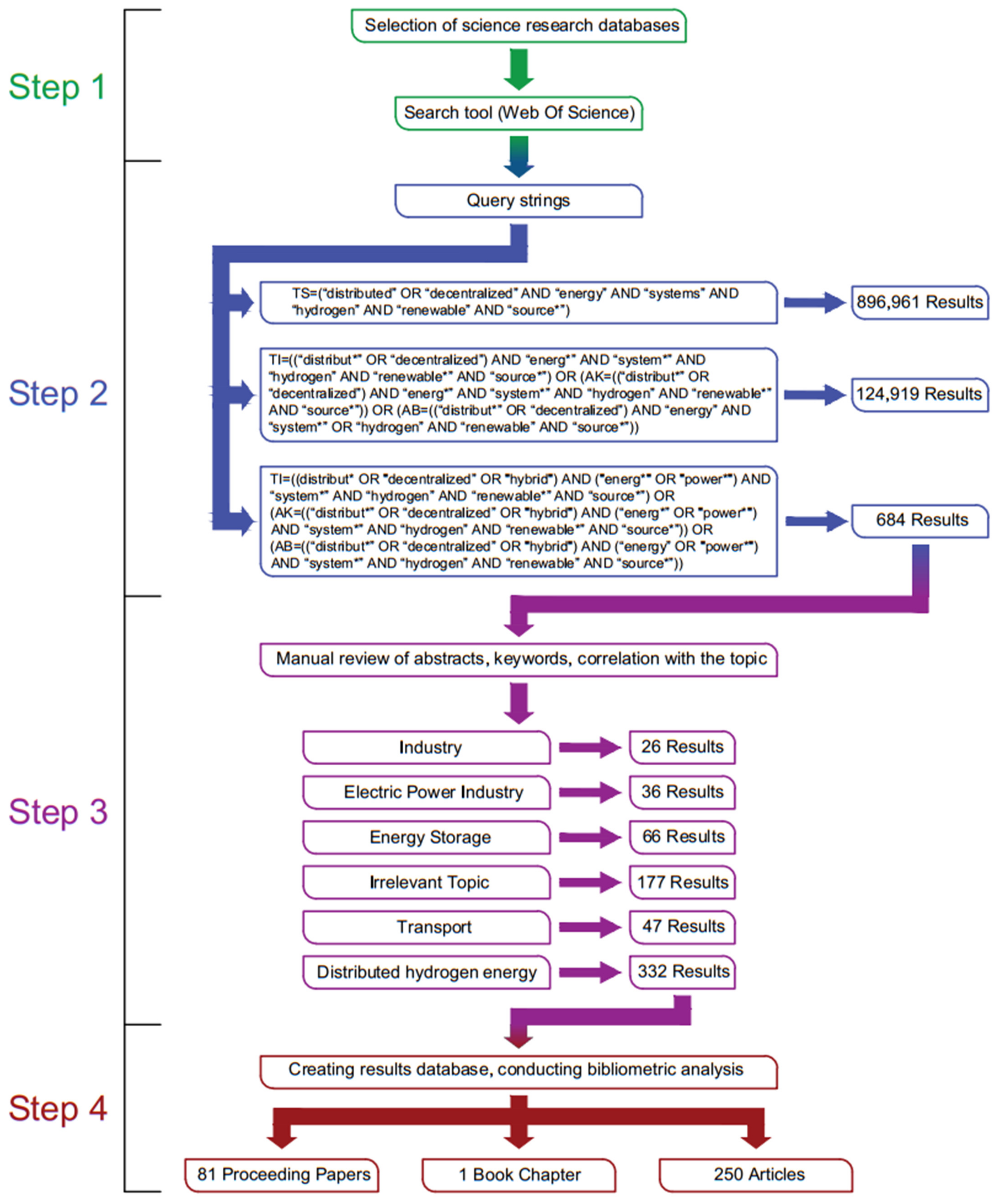

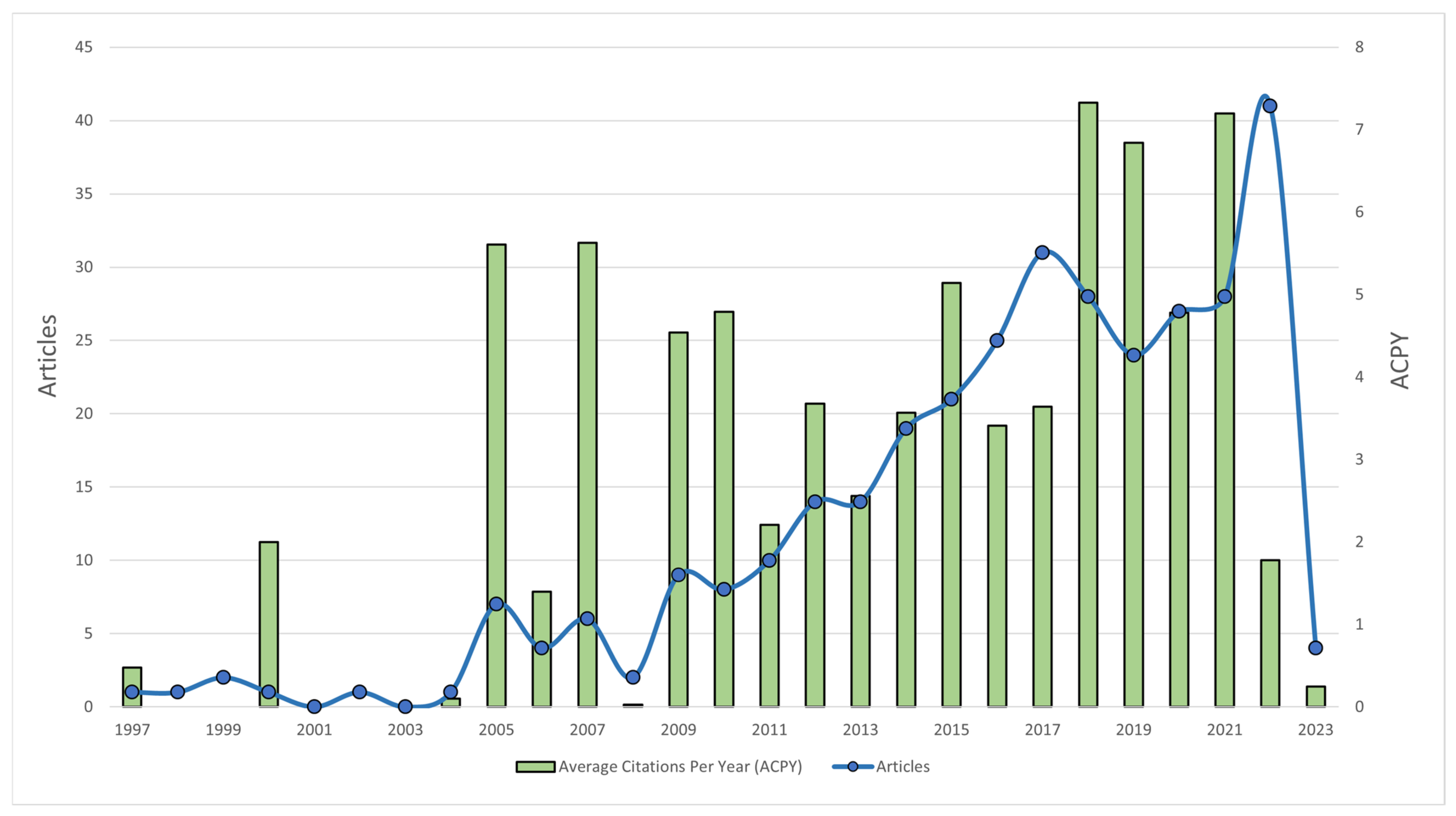
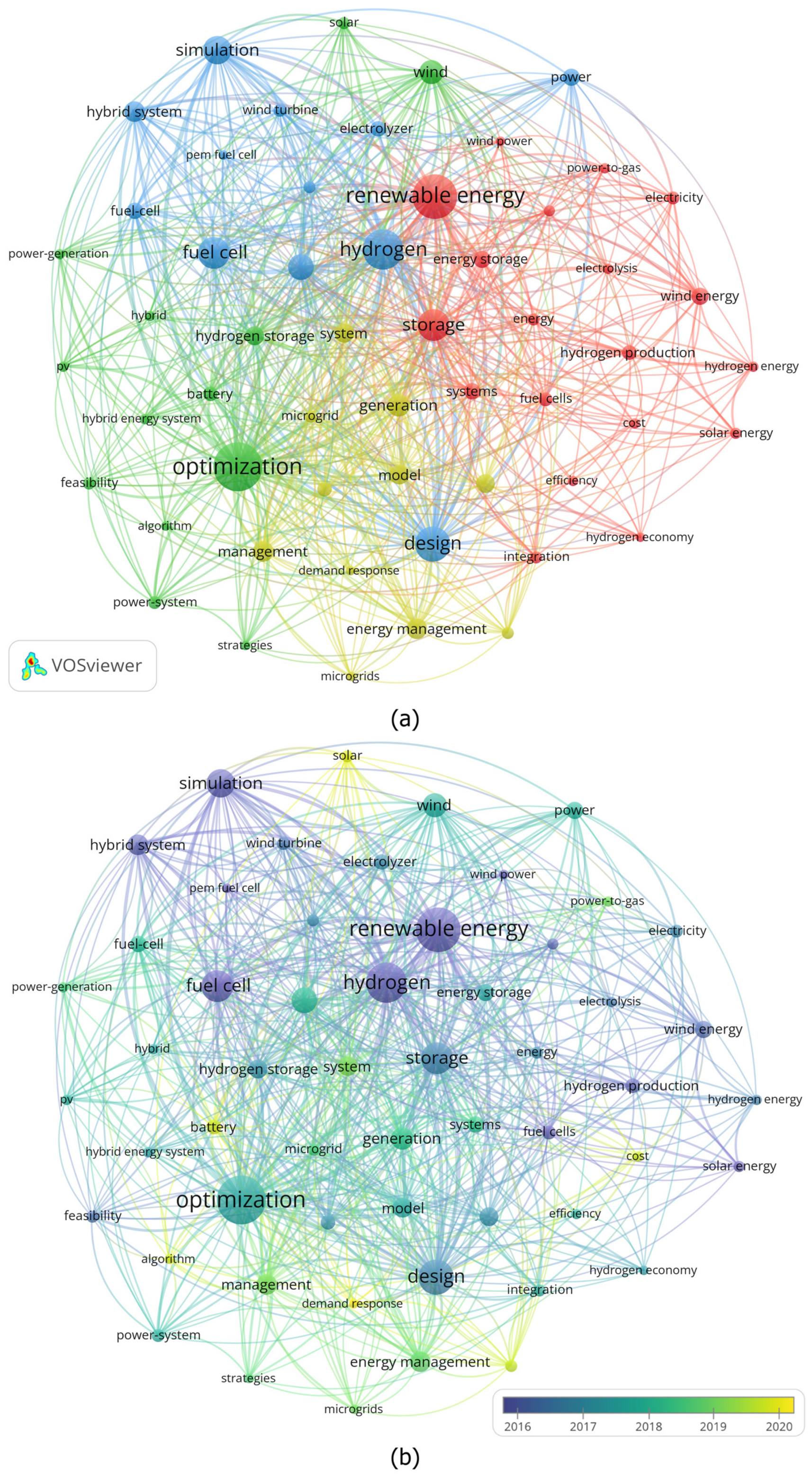
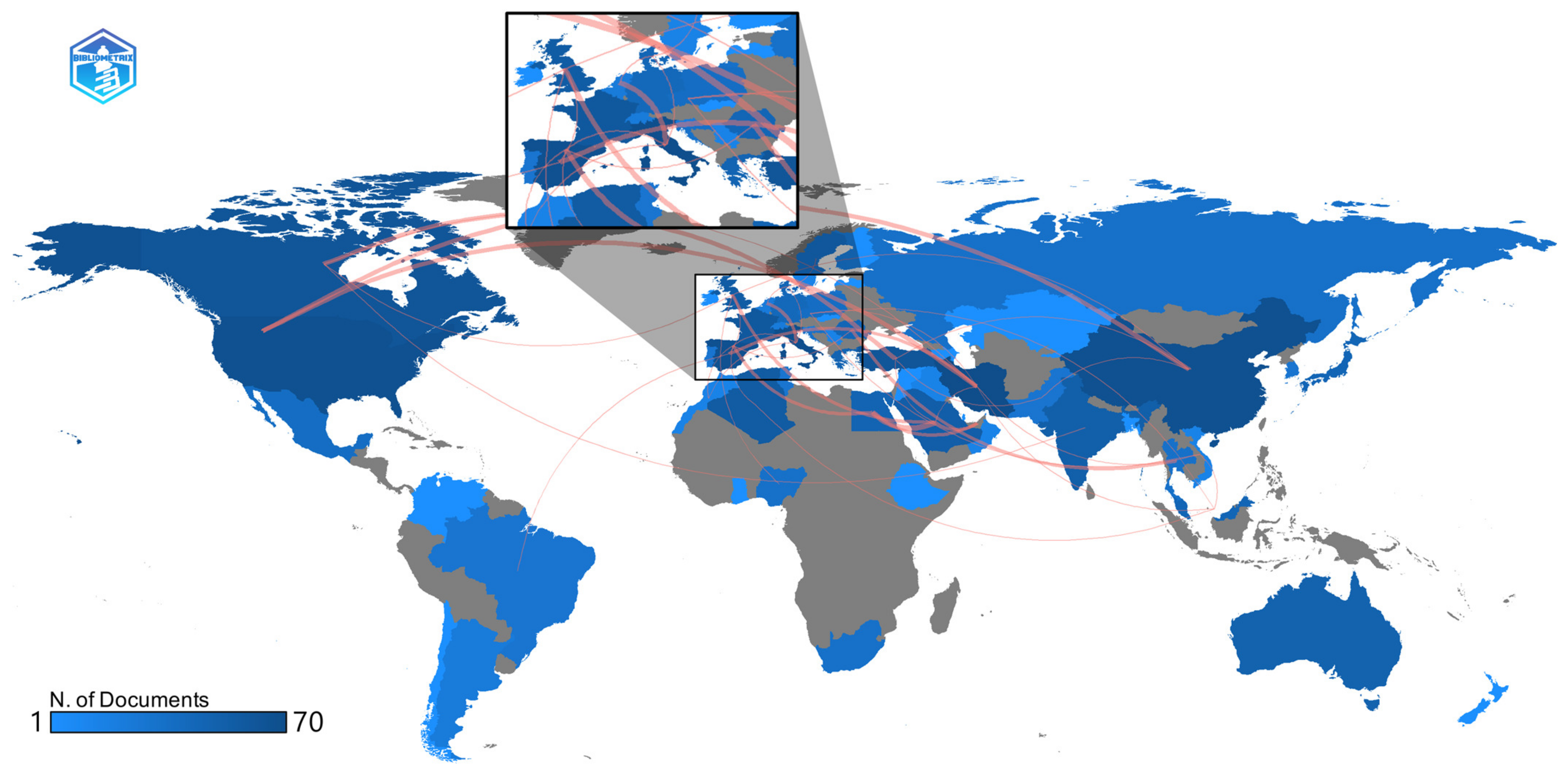
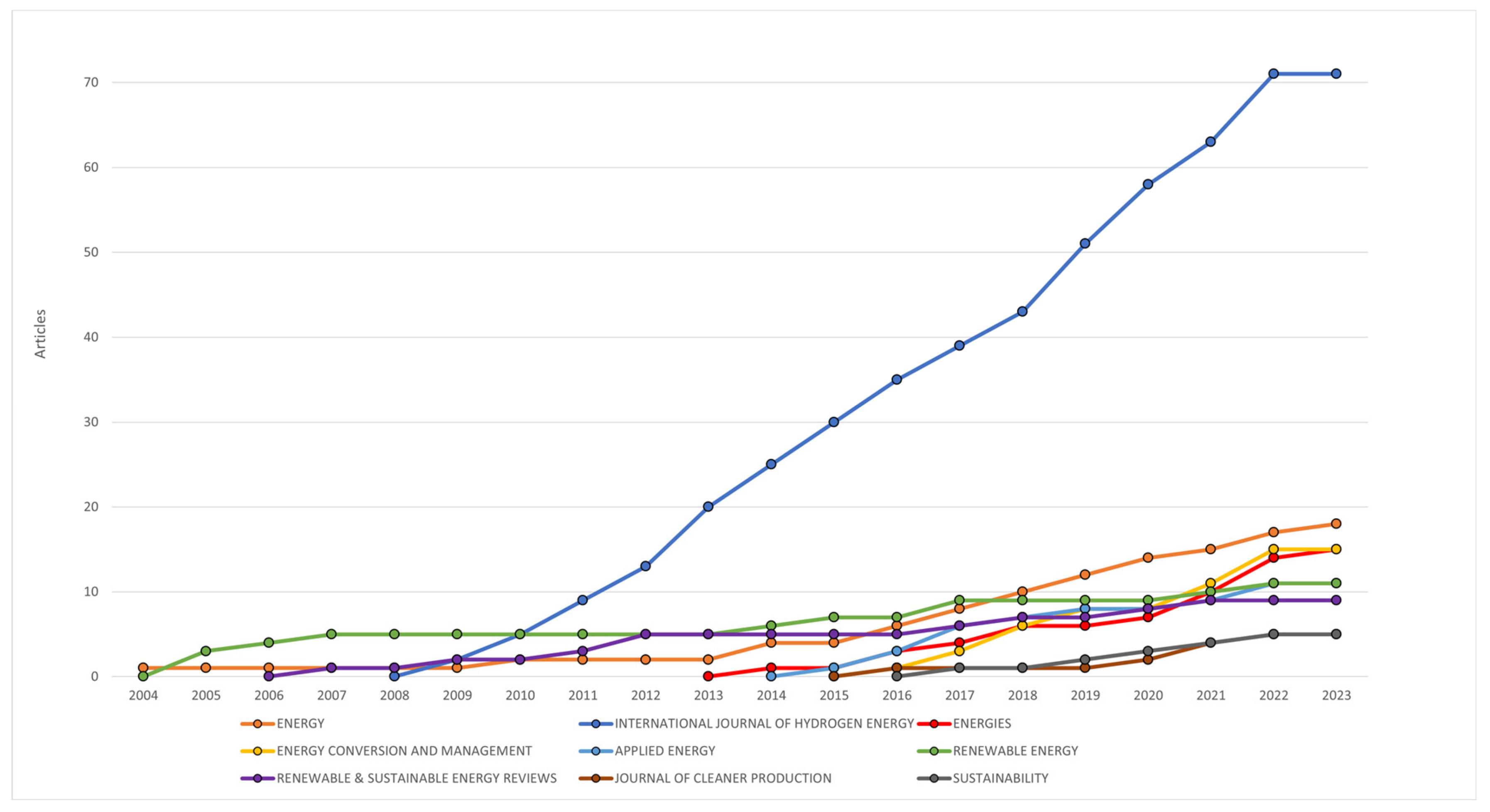
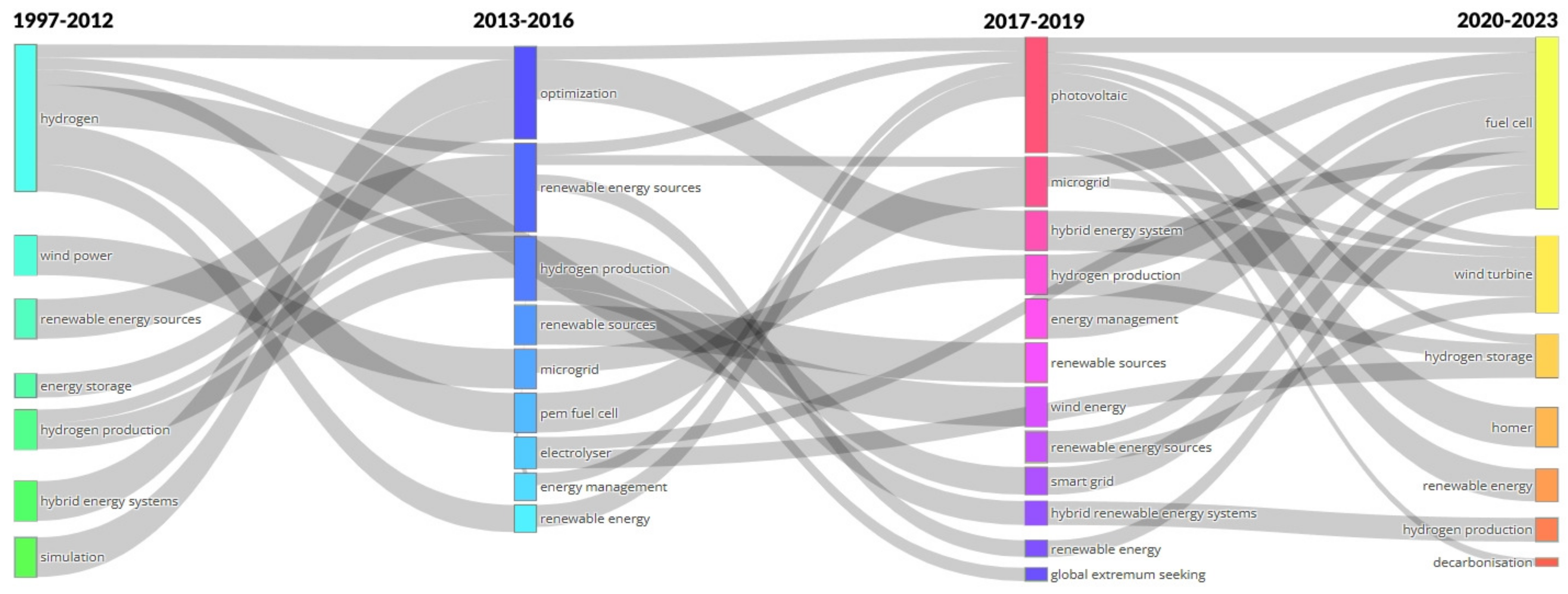
| Authors | Article Title | Journal (Publisher) | Year | Citations * |
|---|---|---|---|---|
| Sgarbossa et al. [29] | Renewable hydrogen supply chains: A planning matrix and an agenda for future research | International Journal of Production Economics (Elsevier) | 2023 | 3 |
| Homa et al. [30] | Small-Scale Hybrid and Polygeneration Renewable Energy Systems: Energy Generation and Storage Technologies, Applications, and Analysis Methodology | Energies (MDPI) | 2022 | 1 |
| Ishaq et al. [31] | A review on hydrogen production and utilization: Challenges and opportunities | International Journal of Hydrogen Energy (Elsevier) | 2022 | 81 |
| Khan et al. [32] | Review on recent optimization strategies for hybrid renewable energy system with hydrogen technologies: State of the art, trends and future directions | International Journal of Hydrogen Energy (Elsevier) | 2022 | 19 |
| Sorrenti et al. [33] | The role of power-to-X in hybrid renewable energy systems: A comprehensive review | Renewable & Sustainable Energy Reviews (Elsevier) | 2022 | 7 |
| Ozturk and Dincer [34] | A comprehensive review on power-to-gas with hydrogen options for cleaner applications | International Journal of Hydrogen Energy (Elsevier) | 2021 | 55 |
| Mtolo and Saha [35] | A Review of the Optimization and Control Strategies for Fuel Cell Power Plants in a Microgrid Environment | Institute of Electrical and Electronics Engineers (IEEE) | 2021 | 4 |
| Fonseca et al. [36] | Trends in the design of distributed energy systems using hydrogen as energy vector: A systematic literature review | International Journal of Hydrogen Energy (Elsevier) | 2019 | 76 |
| Authors | Purpose of the Paper | Journal (Publisher) | Year |
|---|---|---|---|
| Jasinski et al. [67] | Review and categorization of the use of mathematical optimization methods, including robust and hybrid techniques in the management and planning of multi-carrier energy systems. | Institute of Electrical and Electronics Engineers (IEEE) | 2023 |
| Islam et al. [68] | Review and assessment of renewable energy potential, including solar and wind power with hydrogen storage for remote communities in Far North Queensland, Australia, currently reliant on costly diesel generators. | International Journal of Energy and Environmental Engineering (Springer) | 2022 |
| Alzahrani et al. [69] | Study of a hybrid microgrid (HMG) system using hydrogen as a primary energy source alongside solar and wind energy, proposal of a control method for a bidirectional AC-DC converter. | Energies (MDPI) | 2022 |
| Wimalaratna et al. [70] | Review the integration of wind energy into hybrid renewable energy systems around the world, considering both economic and technical factors to optimize system efficiency, reduce costs, and enhance off-grid operation. | Sustainable Energy Technologies and Assessments (Elsevier) | 2022 |
| Pei et al. [71] | Comparison of different hydrogen production systems and analysis of the operational constraints and characteristics of a DC microgrid (MG) with an electric-hydrogen hybrid energy storage system (ESS). | Journal of Power and Energy Systems (CSEE) | 2022 |
| Ogbonnaya et al. [72] | Systematic update on the state-of-the-art of Integrated Photovoltaic-Fuel Cell (IPVFC) systems, an overview of the technical challenges that need to be overcome for IPVFC systems to reach full commercialization and widespread application. | Energies (MDPI) | 2021 |
| Herencic et al. [73] | Presentation of a unified model to assess the techno-economic performances of multi-vector energy communities (MECs), emphasizing their potential to provide flexibility and ability to enhance local renewable energy utilization. | Energy Conversion and Management (Elsevier) | 2021 |
| Naderipour et al. [74] | Comparative evaluation of optimal designs for hybrid renewable and clean energy systems, using a photovoltaic, wind turbine, tidal, and fuel cell energies with hydrogen storage in three regions of Iran. | Journal of Cleaner Production (Elsevier) | 2021 |
| Jahannoosh et al. [75] | Presentation of an optimal and cost-effective design for a hybrid renewable energy system using a photovoltaic, wind turbine, and fuel cells for residential-commercial centres in Iran. | Journal of Cleaner Production (Elsevier) | 2021 |
| Keyword | Cluster | Links | Occurrences | Average Citations |
|---|---|---|---|---|
| renewable energy | 1 | 53 | 79 | 44.34 |
| storage | 1 | 54 | 50 | 39.44 |
| wind energy | 1 | 43 | 23 | 63.09 |
| energy storage | 1 | 41 | 22 | 33.18 |
| systems | 1 | 37 | 21 | 21.90 |
| hydrogen production | 1 | 28 | 18 | 45.61 |
| fuel cells | 1 | 36 | 17 | 35.53 |
| electricity | 1 | 36 | 16 | 58.88 |
| energy | 1 | 31 | 14 | 25.93 |
| integration | 1 | 34 | 14 | 29.86 |
| hydrogen-production | 1 | 31 | 13 | 45.92 |
| solar energy | 1 | 28 | 13 | 72.46 |
| cost | 1 | 31 | 12 | 31.17 |
| efficiency | 1 | 31 | 12 | 22.50 |
| electrolysis | 1 | 36 | 12 | 55.75 |
| hydrogen energy | 1 | 29 | 12 | 46.00 |
| power-to-gas | 1 | 28 | 12 | 54.58 |
| hydrogen economy | 1 | 31 | 10 | 25.10 |
| wind power | 1 | 27 | 10 | 51.40 |
| optimization | 2 | 54 | 89 | 42.30 |
| wind | 2 | 49 | 35 | 37.66 |
| hydrogen storage | 2 | 45 | 25 | 44.04 |
| battery | 2 | 41 | 19 | 31.95 |
| power-system | 2 | 32 | 16 | 41.56 |
| feasibility | 2 | 32 | 15 | 54.40 |
| solar | 2 | 34 | 15 | 25.87 |
| hybrid | 2 | 31 | 12 | 18.83 |
| hybrid energy system | 2 | 26 | 12 | 21.00 |
| power-generation | 2 | 31 | 12 | 26.17 |
| pv | 2 | 36 | 12 | 36.08 |
| algorithm | 2 | 31 | 11 | 25.45 |
| strategies | 2 | 27 | 10 | 13.50 |
| hydrogen | 3 | 53 | 68 | 30.29 |
| design | 3 | 51 | 57 | 31.46 |
| fuel cell | 3 | 42 | 50 | 28.90 |
| simulation | 3 | 49 | 43 | 32.81 |
| performance | 3 | 47 | 39 | 32.79 |
| hybrid system | 3 | 39 | 28 | 37.68 |
| power | 3 | 39 | 22 | 28.36 |
| fuel-cell | 3 | 36 | 21 | 36.48 |
| electrolyzer | 3 | 36 | 20 | 30.90 |
| wind turbine | 3 | 36 | 16 | 24.56 |
| photovoltaic | 3 | 34 | 14 | 22.50 |
| pem fuel cell | 3 | 27 | 11 | 33.27 |
| generation | 4 | 45 | 31 | 28.84 |
| energy management | 4 | 42 | 28 | 19.43 |
| management | 4 | 43 | 28 | 34.25 |
| model | 4 | 52 | 27 | 28.96 |
| system | 4 | 44 | 27 | 31.59 |
| renewable energy sources | 4 | 41 | 25 | 15.24 |
| operation | 4 | 44 | 18 | 34.94 |
| microgrid | 4 | 25 | 14 | 12.79 |
| technologies | 4 | 38 | 14 | 36.07 |
| demand response | 4 | 32 | 10 | 12.30 |
| Microgrids | 4 | 27 | 10 | 32.20 |
Disclaimer/Publisher’s Note: The statements, opinions and data contained in all publications are solely those of the individual author(s) and contributor(s) and not of MDPI and/or the editor(s). MDPI and/or the editor(s) disclaim responsibility for any injury to people or property resulting from any ideas, methods, instructions or products referred to in the content. |
© 2023 by the authors. Licensee MDPI, Basel, Switzerland. This article is an open access article distributed under the terms and conditions of the Creative Commons Attribution (CC BY) license (https://creativecommons.org/licenses/by/4.0/).
Share and Cite
Ogarek, P.; Wojtoń, M.; Słyś, D. Hydrogen as a Renewable Energy Carrier in a Hybrid Configuration of Distributed Energy Systems: Bibliometric Mapping of Current Knowledge and Strategies. Energies 2023, 16, 5495. https://doi.org/10.3390/en16145495
Ogarek P, Wojtoń M, Słyś D. Hydrogen as a Renewable Energy Carrier in a Hybrid Configuration of Distributed Energy Systems: Bibliometric Mapping of Current Knowledge and Strategies. Energies. 2023; 16(14):5495. https://doi.org/10.3390/en16145495
Chicago/Turabian StyleOgarek, Przemysław, Michał Wojtoń, and Daniel Słyś. 2023. "Hydrogen as a Renewable Energy Carrier in a Hybrid Configuration of Distributed Energy Systems: Bibliometric Mapping of Current Knowledge and Strategies" Energies 16, no. 14: 5495. https://doi.org/10.3390/en16145495
APA StyleOgarek, P., Wojtoń, M., & Słyś, D. (2023). Hydrogen as a Renewable Energy Carrier in a Hybrid Configuration of Distributed Energy Systems: Bibliometric Mapping of Current Knowledge and Strategies. Energies, 16(14), 5495. https://doi.org/10.3390/en16145495







